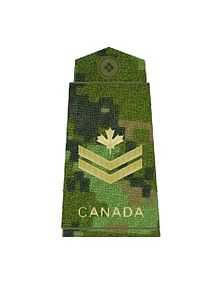Master corporal
Master Corporal (MCpl) (French: caporal-chef or cplc), in the Canadian Armed Forces and the Royal Canadian Army Cadets is an appointment of the rank of Corporal in the Canadian Army and Royal Canadian Airforce. Its Naval equivalent is Master Seaman (MS) (French: matelot-chef or matc).
According to the Queen's Regulations and Orders:
(1) The Chief of the Defence Staff or such officer as he may designate may appoint a corporal as a master corporal.
(2) The rank of a master corporal remains that of corporal.
(4) Master corporals have authority and powers of command over all other corporals." — QR&O 3.08
(3) Master corporals have seniority among themselves in their order of seniority as corporals.
Master Corporal, while formally an appointment, is treated as a de facto non-commissioned member rank, and is often described as such, even in official documents.
As mentioned above, the Master Corporal is senior to the Corporal (and its Naval counterpart, Leading Seaman). It is junior to the rank of Sergeant (Sgt) and its equivalent naval rank, Petty Officer 2nd Class (PO2). Master Corporals and Master Seamen together with Corporals and Leading Seamen make up the cadre of junior non-commissioned officers.

The rank insignia of a Master Corporal is a 2-bar chevron, worn point down, surmounted by a maple leaf. Embroidered rank badges are worn in "CF gold" thread on rifle green (Army) or Air Force blue (Air Force) melton, stitched to the upper sleeves of the Service Dress jacket; as miniature gold metal and rifle-green enamel badges on the collars of the Army dress shirt and Army outerwear jackets; in "old-gold" thread on Air Force blue slip-ons on Air Force shirts, sweaters, and coats; and in tan (Army) or dark blue (Air Force) thread on CADPAT slip-ons on the Operational Dress uniform. Insignia for mess kit is determined by branch or regimental tradition.
Master Corporals normally mess and billet with the Junior Ranks. Within most Canadian Army units, Master Corporals are commonly nicknamed "Master Jack" or "Jack" by both superiors and subordinates. This is an informality and is only used within social context and never in formal proceedings. Only in closer working or socially comfortable units like rifle regiments or infantry units in general is this informal term commonly used. Master Corporals are also frequently referred to as "Chef" in Quebec, a reference to the French translation of the rank, Caporal-chef.
History
The Master Corporal appointment came into existence after the unification of the Canadian Forces in the mid 60s. A power vacuum was inadvertently created when private soldiers were promoted to the rank of corporal as an incentive for continuing in the Forces at a time when Unification was introduced by Defence Minister Hellyer, who promoted all privates with requisite time in service to what was originally a leadership rank (corporal) in the Army. Eventually, corporals who had passed the "B" phase of their leadership training took to wearing a crown over their chevrons, and this arrangement was eventually formalized by having a maple leaf replace the crown, and the new "'B' Corporals", as they were known, became Master Corporals.
Responsibilities
The rank, formally an appointment as a senior corporal, gives the MCpl authority over all privates and corporals. As such, a MCpl is a first level supervisor who will be assessed on his/her ability to manage and develop subordinates. Given the structure of the Canadian infantry platoon, the MCpl is roughly equivalent to the British rank of lance corporal, second in command of an infantry section.
Requirements
The general requirements for promotion to Master Corporal include a Qualification Level 5 course (known as a Journeyman course in some trades), a primary leadership qualification course (PLQ), and a time in the rank of Corporal for a minimum of two years.
However, certain trades have their own particular qualifications in addition to the above. For example, infantry combines the Qualification Level 5B course, Qualification Level 6A, and Junior Leader's course in a single Infantry Section Commander's Course. In addition, in order to be promoted to Master Corporal an infantry soldier must have successfully completed a machine gunner's specialization course.
Master Corporals often serve as Training Non-Commissioned Officers for the purposes of training new soldiers. They are often a new recruit's first taste of military life.